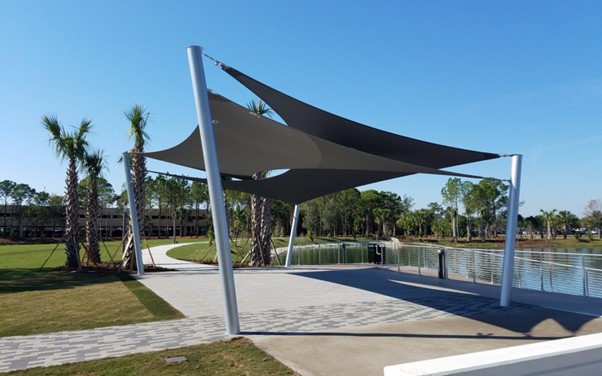Buildings that block reflected and disperse UVR provide the finest shade. Alternatively, trees, plants, neighbouring structures or objects, awnings, tents, and shade sails can give shade outside. Permanent, transient, or moveable.
Apply a mixture of the five sun protection strategies when the UV index is 3 or higher: Put on sunscreen, a hat, shade, and sunglasses.
Best shades
- Shaded area
The sky scatters as much solar UVR as the sun for most of the day. Consider direct and scattered sun UVR for the best protection.
Positioning the building and the person under it relative to the sun determines shade coverage with outdoor shade supplier UAE. Large shade structures provide more protection than small ones. Variations in design, the height of the shade canopy above the person, deterioration of the materials, sunlight direction, and the person’s location are also factors in shade structures of structural fabrication companies in UAE. Generally, less sky means more shielding from scattered solar UVR.
Shade helps, but if a person is outside during sun protection hours, they need all five methods.
Snow, water, and buildings reflect UVR. Solid surfaces like steel, glass, and concrete reflect more UVR than soil and grass. Light colours reflect more.
According to outdoor shades supplier UAE the best shade blocks direct sunlight covers the sky, and protects sides from shiny surfaces. It also considers how shade moves with the sun in the morning, lunchtime, and afternoon.
- Shaded naturally
Different trees shade and reduce UVR differently. The UVR protection of a thick canopy can reach 90%. With 60% UVR protection, a medium canopy is ideal for short stays. Light canopy UVR protection is minimal.
- Manufacturer-made shades
There are permanent, adaptable, temporary, and portable manufactured structures:
Shelter shelters, gazebos, verandas, and shade sails provide permanent shade. Metals, polycarbonates, knitted, and woven shade fabrics are options.
Shade sails, awnings, and café umbrellas are adjustable. Knitted and woven shade fabric is used because they are adaptable.
Large tents, marquees, and beach shelters are easy to set up and take down. They’re commonly knitted or woven shade fabric.
Portable shade, such as beach umbrellas and sun shelters, is usually made of woven shade fabric.
Sun protection materials
The coverage and UVR-reducing materials of a shadow structure determine its effectiveness. Testing the material’s Ultraviolet Effectiveness (UVE) or Protection Factor (PF) for metals, glass, or polycarbonates determines its effectiveness.
- Metal
Metal sheets are used only on permanent shade structures and provide good UVR protection.
- Polycarbonates
Polycarbonate comes in clear or coloured sheets. The sheeting weatherproof outdoor spaces while letting light through. PF 50+ transparent polycarbonates are common.
- Glass
Car windows, retractable doors, windows, and skylights employ glass to enclose or weatherproof outdoor spaces while letting light through. The UV radiation protection of most tempered and plain glass is low. Windscreens, double-glazed, and tinted windows can block over 98% of UVR (PF 50+).
Shade fabrics
Shade fabrics for horticultural usage to limit visible light for plants or human protection based on their ultraviolet effectiveness percentage (% UVE). Fabric shaded by knitting and weaving. Shade fabric includes umbrellas, tents, sun shelters, portable gazebos and marquees, awnings, shade sails, and shade cloth. Shade fabric protection depends on material, colour, density, weave, and coatings. Canvas and silver-backed textiles commonly exceed 98% UVE. Any sun, sky, and reflection-protecting fabric with a 97% UVE rating or higher can block solar UVR all day.
Shade fabric: knit or woven
Shade fabric (sometimes called shade cloth) was originally used in horticulture to restrict visible light and heat while allowing plant ventilation. UV-stabilized HDPE or polypropylene is used to make shade fabrics. Shade fabric’s weave and gauge affect UVR transmission, with closer weaves protecting more. Personal outdoor shade products make use of shade materials that are effective from 80.0 to 90.9% UVE, highly effective from 91.0-94.9%, and most effective from 95% UVE or higher. UVR protection should go beyond a high UVE rating.
In a retrospective cross-sectional study of over 3000 National Health and Nutrition Examination Survey participants, 16% who reported frequently sitting in the shade on sunny days had fewer sunburns and lower 25-hydroxy vitamin D levels. These data imply that shade is an important sun protection method for Americans.
To avoid skin cancer, organisations advocate minimising time outside during peak sun hours, sitting in the shade, wearing long sleeves and slacks, and applying sunscreen (SPF 30) on exposed skin.5 Some shades are more protective than others. Sitting under beach umbrellas would benefit from a clearer definition of deep shadow as of structural fabrication companies in UAE.
